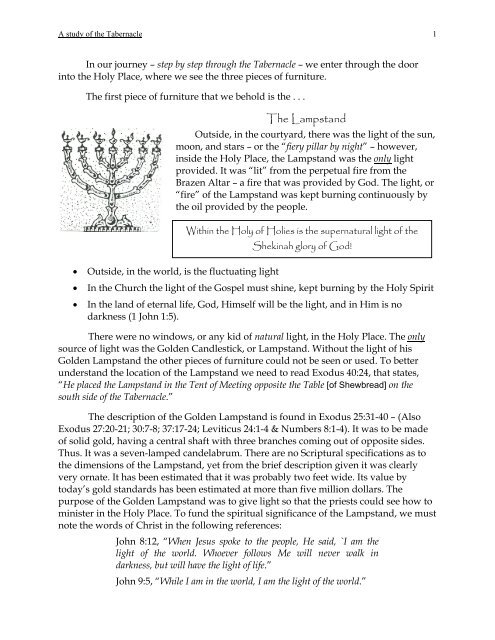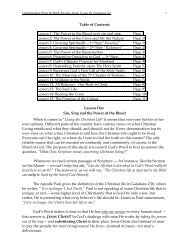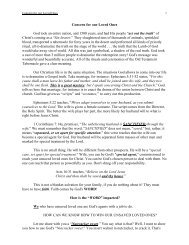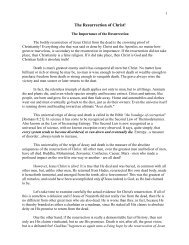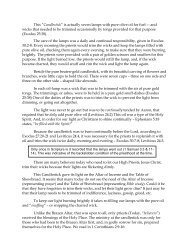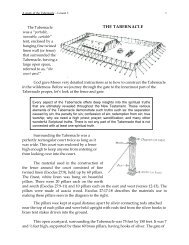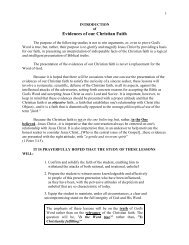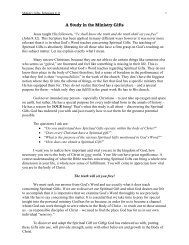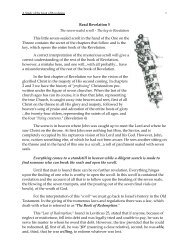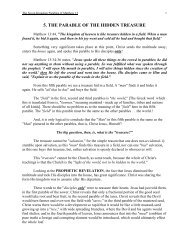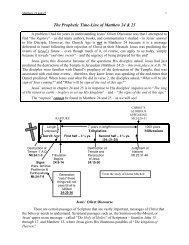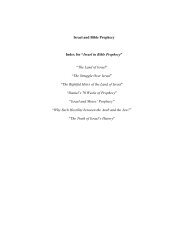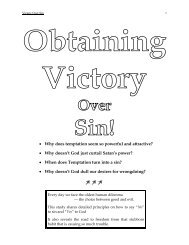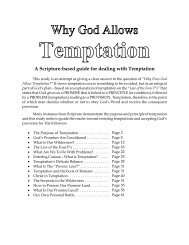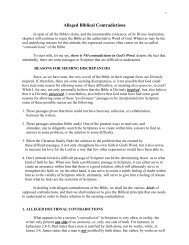A Study of the Tabernacle - NetBibleStudy.com
A Study of the Tabernacle - NetBibleStudy.com
A Study of the Tabernacle - NetBibleStudy.com
You also want an ePaper? Increase the reach of your titles
YUMPU automatically turns print PDFs into web optimized ePapers that Google loves.
A study <strong>of</strong> <strong>the</strong> <strong>Tabernacle</strong> 1<br />
In our journey – step by step through <strong>the</strong> <strong>Tabernacle</strong> – we enter through <strong>the</strong> door<br />
into <strong>the</strong> Holy Place, where we see <strong>the</strong> three pieces <strong>of</strong> furniture.<br />
The first piece <strong>of</strong> furniture that we behold is <strong>the</strong> . . .<br />
The Lampstand<br />
Outside, in <strong>the</strong> courtyard, <strong>the</strong>re was <strong>the</strong> light <strong>of</strong> <strong>the</strong> sun,<br />
moon, and stars – or <strong>the</strong> “fiery pillar by night” – however,<br />
inside <strong>the</strong> Holy Place, <strong>the</strong> Lampstand was <strong>the</strong> only light<br />
provided. It was “lit” from <strong>the</strong> perpetual fire from <strong>the</strong><br />
Brazen Altar – a fire that was provided by God. The light, or<br />
“fire” <strong>of</strong> <strong>the</strong> Lampstand was kept burning continuously by<br />
<strong>the</strong> oil provided by <strong>the</strong> people.<br />
• Outside, in <strong>the</strong> world, is <strong>the</strong> fluctuating light<br />
Within <strong>the</strong> Holy <strong>of</strong> Holies is <strong>the</strong> supernatural light <strong>of</strong> <strong>the</strong><br />
Shekinah glory <strong>of</strong> God!<br />
• In <strong>the</strong> Church <strong>the</strong> light <strong>of</strong> <strong>the</strong> Gospel must shine, kept burning by <strong>the</strong> Holy Spirit<br />
• In <strong>the</strong> land <strong>of</strong> eternal life, God, Himself will be <strong>the</strong> light, and in Him is no<br />
darkness (1 John 1:5).<br />
There were no windows, or any kid <strong>of</strong> natural light, in <strong>the</strong> Holy Place. The only<br />
source <strong>of</strong> light was <strong>the</strong> Golden Candlestick, or Lampstand. Without <strong>the</strong> light <strong>of</strong> his<br />
Golden Lampstand <strong>the</strong> o<strong>the</strong>r pieces <strong>of</strong> furniture could not be seen or used. To better<br />
understand <strong>the</strong> location <strong>of</strong> <strong>the</strong> Lampstand we need to read Exodus 40:24, that states,<br />
“He placed <strong>the</strong> Lampstand in <strong>the</strong> Tent <strong>of</strong> Meeting opposite <strong>the</strong> Table [<strong>of</strong> Shewbread] on <strong>the</strong><br />
south side <strong>of</strong> <strong>the</strong> <strong>Tabernacle</strong>.”<br />
The description <strong>of</strong> <strong>the</strong> Golden Lampstand is found in Exodus 25:31-40 – (Also<br />
Exodus 27:20-21; 30:7-8; 37:17-24; Leviticus 24:1-4 & Numbers 8:1-4). It was to be made<br />
<strong>of</strong> solid gold, having a central shaft with three branches <strong>com</strong>ing out <strong>of</strong> opposite sides.<br />
Thus. It was a seven-lamped candelabrum. There are no Scriptural specifications as to<br />
<strong>the</strong> dimensions <strong>of</strong> <strong>the</strong> Lampstand, yet from <strong>the</strong> brief description given it was clearly<br />
very ornate. It has been estimated that it was probably two feet wide. Its value by<br />
today’s gold standards has been estimated at more than five million dollars. The<br />
purpose <strong>of</strong> <strong>the</strong> Golden Lampstand was to give light so that <strong>the</strong> priests could see how to<br />
minister in <strong>the</strong> Holy Place. To fund <strong>the</strong> spiritual significance <strong>of</strong> <strong>the</strong> Lampstand, we must<br />
note <strong>the</strong> words <strong>of</strong> Christ in <strong>the</strong> following references:<br />
John 8:12, “When Jesus spoke to <strong>the</strong> people, He said, `I am <strong>the</strong><br />
light <strong>of</strong> <strong>the</strong> world. Whoever follows Me will never walk in<br />
darkness, but will have <strong>the</strong> light <strong>of</strong> life.”<br />
John 9:5, “While I am in <strong>the</strong> world, I am <strong>the</strong> light <strong>of</strong> <strong>the</strong> world.”
A study <strong>of</strong> <strong>the</strong> <strong>Tabernacle</strong> 2<br />
We proceed, with bowed heads, and a deep sense <strong>of</strong> reverence, into <strong>the</strong> Holy<br />
Place, reserved for <strong>the</strong> priests unto God – for it is <strong>the</strong> dwelling place <strong>of</strong> God.<br />
The priests hold back <strong>the</strong> beautiful colored tapestry <strong>of</strong> <strong>the</strong> door and we step in<br />
between <strong>the</strong> golden pillars into <strong>the</strong> Holy Place.<br />
Are we entitled to this close relationship with God?<br />
Lampstand<br />
The steps we have taken to get this far:<br />
Altar <strong>of</strong> Incense<br />
Table <strong>of</strong><br />
Shewbread<br />
1. We have passed through THE GATE that stands for <strong>the</strong> Gospels, that<br />
is, we have accepted Christ in His four-fold character.<br />
2. We have been to <strong>the</strong> BRAZEN ALTAR, a picture <strong>of</strong> Christ’s cross, that<br />
is, we have <strong>com</strong>e to God by way <strong>of</strong> <strong>the</strong> cross.<br />
3. We visited <strong>the</strong> LAVER, that represents being cleansed, or separated,<br />
from <strong>the</strong> world and things that defile. This means that we have been<br />
washed in “<strong>the</strong> Laver” <strong>of</strong> God’s Word.<br />
Upon entering <strong>the</strong> Holy Place we view <strong>the</strong> room 30 feet long, 15 feet wide, and<br />
15 feet high. At first, our eyes must be<strong>com</strong>e accustomed to <strong>the</strong> dim light <strong>of</strong> <strong>the</strong> lamps,<br />
and we cannot help but be impressed with <strong>the</strong> sweet fragrance <strong>of</strong> burning incense. The<br />
walls are burnished gold, and <strong>the</strong> veil –- we have just passed through –- is <strong>of</strong> many<br />
colors with golden needlework.<br />
In spite <strong>of</strong> all this luster, we note <strong>the</strong> simplicity <strong>of</strong> <strong>the</strong> furnishings. To our right is<br />
<strong>the</strong> Table <strong>of</strong> Shewbread; to our life <strong>the</strong> Golden Candlestick, or Lampstand, and directly<br />
in front <strong>of</strong> us, across <strong>the</strong> room, is <strong>the</strong> Altar <strong>of</strong> Incense.<br />
This “Candlestick” is actually seven lamps with pure olive oil for fuel –- and<br />
wicks that needed to be trimmed occasionally by tongs provided for that purpose<br />
(Exodus 25:38).<br />
The care <strong>of</strong> <strong>the</strong> lamps was a daily and continual responsibility, given in Exodus<br />
30:2-8. Every morning <strong>the</strong> priests would trim <strong>the</strong> wicks and keep <strong>the</strong> lamps filled with<br />
pure olive oil, checking <strong>the</strong>m again every evening, to make sure that <strong>the</strong>y were burning
A study <strong>of</strong> <strong>the</strong> <strong>Tabernacle</strong> 3<br />
brightly. The priests were provided with a pair <strong>of</strong> golden scissors and snuffers for this<br />
purpose. If <strong>the</strong> light burned low, <strong>the</strong> priests would refill <strong>the</strong> lamp, and, if <strong>the</strong> wick<br />
became charred, <strong>the</strong>y would snuff and rim <strong>the</strong> wick and light <strong>the</strong> lamp again.<br />
Beside <strong>the</strong> pure beaten-gold candlestick, with its beautiful carving <strong>of</strong> flowers and<br />
branches, were little cups to hold <strong>the</strong> oil. There were seven cups – three on one side and<br />
three on <strong>the</strong> o<strong>the</strong>r side – shaped like almonds.<br />
In each oil-lamp was a wick that was to be trimmed with <strong>the</strong> air <strong>of</strong> pure gold<br />
tongs. The trimmings, or ashes, were to be held in a pure gold snuff-dishes (Exodus<br />
25:38) One <strong>of</strong> <strong>the</strong> duties <strong>of</strong> <strong>the</strong> priests was to trim <strong>the</strong> wick to prevent <strong>the</strong> light from<br />
dimming, or going out altoge<strong>the</strong>r.<br />
The light was never to go out but was to be continually tended by Aaron, that<br />
required that he daily add pure olive oil (Leviticus 24:2) This oil was a type <strong>of</strong> <strong>the</strong> Holy<br />
Spirit. And, in order for our light as Christians to shine continually – Ephesians 5:18<br />
states, “be filled with <strong>the</strong> Spirit!”<br />
Because <strong>the</strong> candlestick was to burn continually before <strong>the</strong> Lord, according to<br />
Exodus 27:20-21 and Leviticus 24:4, it was necessary for <strong>the</strong> priests to replenish it with<br />
oil and trim <strong>the</strong> wick twice daily, morning and evening – Exodus 30:7-8; Leviticus 24:3.<br />
Only once in Scripture is it recorded that <strong>the</strong> lamps went out (1 Samuel 3:3 & 11-<br />
14). This was indicative <strong>of</strong> <strong>the</strong> backslidden condition <strong>of</strong> <strong>the</strong> priesthood at <strong>the</strong> time.<br />
There are many believers today who need to let our High Priests, Jesus Christ,<br />
trim <strong>the</strong>ir wicks because <strong>the</strong>ir lights are flickering dimly.<br />
This Candlestick gave its light on <strong>the</strong> Altar <strong>of</strong> Incense and <strong>the</strong> Table <strong>of</strong><br />
Shewbread. It seems that many today do not see <strong>the</strong> need <strong>of</strong> <strong>the</strong> Alter <strong>of</strong> Incense<br />
(representing prayer) and <strong>the</strong> Table <strong>of</strong> Shewbread (representing Bible study). Could it be<br />
that <strong>the</strong>y have forgotten to trim <strong>the</strong>ir wicks, and let <strong>the</strong>ir light grow dim? It just may be<br />
that <strong>the</strong>ir lamp needs to be trimmed <strong>of</strong> indifference, laziness, gossip, greed, etc.<br />
To keep our light burning brightly it takes re-filling our lamps with <strong>the</strong> pure oil<br />
and “snuffing” – or snipping <strong>the</strong> charred wick.<br />
Unlike <strong>the</strong> Brazen Altar, that was open to all, only priests (Today, “believers”)<br />
received <strong>the</strong> blessings <strong>of</strong> <strong>the</strong> Holy Place. The ministry at <strong>the</strong> candlestick was only for<br />
those who had been to <strong>the</strong> Brazen Altar first, and, in godly sorrow for sin, prepared<br />
<strong>the</strong>mselves for <strong>the</strong> Holy Place. We read in 1 Corinthians 2:9-16:<br />
But as it is written, Eye hath not seen, nor ear heard, nei<strong>the</strong>r have entered into<br />
<strong>the</strong> heart <strong>of</strong> man, <strong>the</strong> things which God hath prepared for <strong>the</strong>m that love him.<br />
But God hath revealed <strong>the</strong>m unto us by his Spirit: for <strong>the</strong> Spirit searcheth all<br />
things, yea, <strong>the</strong> deep things <strong>of</strong> God. For what man knoweth <strong>the</strong> things <strong>of</strong> a man,<br />
save <strong>the</strong> spirit <strong>of</strong> man which is in him? even so <strong>the</strong> things <strong>of</strong> God knoweth no<br />
man, but <strong>the</strong> Spirit <strong>of</strong> God. Now we have received, not <strong>the</strong> spirit <strong>of</strong> <strong>the</strong> world,<br />
but <strong>the</strong> spirit which is <strong>of</strong> God; that we might know <strong>the</strong> things that are freely
A study <strong>of</strong> <strong>the</strong> <strong>Tabernacle</strong> 4<br />
given to us <strong>of</strong> God. Which things also we speak, not in <strong>the</strong> words which man's<br />
wisdom teacheth, but which <strong>the</strong> Holy Ghost teacheth; <strong>com</strong>paring spiritual things<br />
with spiritual. But <strong>the</strong> natural man receiveth not <strong>the</strong> things <strong>of</strong> <strong>the</strong> Spirit <strong>of</strong> God:<br />
for <strong>the</strong>y are foolishness unto him: nei<strong>the</strong>r can he know <strong>the</strong>m, because <strong>the</strong>y are<br />
spiritually discerned. But he that is spiritual judgeth all things, yet he himself is<br />
judged <strong>of</strong> no man. For who hath known <strong>the</strong> mind <strong>of</strong> <strong>the</strong> Lord, that he may<br />
instruct him? But we have <strong>the</strong> mind <strong>of</strong> Christ.”<br />
Light is used in Scripture as an expression <strong>of</strong> God’s and <strong>the</strong> Christian’s character.<br />
(See Luke 2:32; 1 John 1:5; Mat<strong>the</strong>w 5:16; Ephesians 5:8) Consequently, men who walk<br />
contrary to God are said to “be in darkness” (John 3:19 & 1 John 1:6).<br />
Light is linked to Christ, and His identifies Himself as “<strong>the</strong> Light <strong>of</strong> <strong>the</strong> world.” The<br />
means <strong>of</strong> imparting light in <strong>the</strong> Holy Place was ac<strong>com</strong>plished when <strong>the</strong> priest poured<br />
<strong>the</strong> pure olive oil into <strong>the</strong> lamps that produced <strong>the</strong> illumination, speaking <strong>of</strong> <strong>the</strong><br />
illumination that is imparted by Christ.<br />
Thee is a beautiful picture here, in that <strong>the</strong> central step is typical <strong>of</strong> Christ and<br />
<strong>the</strong> branches representative <strong>of</strong> <strong>the</strong> Church, because <strong>the</strong> Church is also <strong>the</strong> “light <strong>of</strong> <strong>the</strong><br />
world,” yet, what light it does have <strong>com</strong>es forth from Christ. Jesus said, “I am <strong>the</strong> vine, ye<br />
are <strong>the</strong> branches” (John 15:5).<br />
The branches were constructed so that <strong>the</strong>y could not possibly be used for<br />
anything unless <strong>the</strong>y were attached to <strong>the</strong> central stem. They were “curved” so that <strong>the</strong>y<br />
could not “stand alone.”<br />
Because we, as believers, are in Christ, we have be<strong>com</strong>e “blameless and pure,<br />
children <strong>of</strong> God without fault in a crooked and depraved generation in which we shine like stars<br />
in <strong>the</strong> universe” (Philippians 2:15), and “we were once in darkness, but now we are light in <strong>the</strong><br />
Lord,” and we, thus, “live as children <strong>of</strong> light” (Ephesians 2:8).<br />
Each <strong>of</strong> <strong>the</strong> seven lamps on <strong>the</strong> Lampstand gave an individual light, yet all were<br />
untied to <strong>the</strong> one central branch that literally was “in <strong>the</strong> midst.”<br />
John said in Revelation 1:12-13, “And I turned to see <strong>the</strong> voice that spake with me.<br />
And being turned, I saw seven golden candlesticks; And in <strong>the</strong> midst <strong>of</strong> <strong>the</strong> seven candlesticks<br />
one like unto <strong>the</strong> Son <strong>of</strong> man, clo<strong>the</strong>d with a garment down to <strong>the</strong> foot, and a golden sash<br />
around His chest.” Then Christ said to John in verse 20, “The mystery <strong>of</strong> <strong>the</strong> seven stars<br />
which you saw in My right hand, and <strong>the</strong> seven golden candlesticks . . . is this, <strong>the</strong> seven<br />
candlesticks which you saw are <strong>the</strong> seven churches.<br />
Though each candlestick (churches) was independent <strong>of</strong> each o<strong>the</strong>r, all were<br />
attached to <strong>the</strong> central shaft. The Lord Jesus Christ.<br />
Each branch <strong>of</strong> <strong>the</strong> Lampstand was to have hammered out “a knob and a flower<br />
in one branch; and three bowls made like almonds” (Exodus 25:33). It is generally<br />
believed that <strong>the</strong> knobs were pomegranates and <strong>the</strong> flowers were lilies. The emphasis is<br />
clearly on <strong>the</strong> almond design, reminding us <strong>of</strong> Aaron’s rod from an almond tree that
A study <strong>of</strong> <strong>the</strong> <strong>Tabernacle</strong> 5<br />
budded (Number 17:1-11). Aaron’s dead almond limb came to life in <strong>the</strong> <strong>Tabernacle</strong>, an<br />
undeniable picture <strong>of</strong> resurrection – <strong>the</strong> dead <strong>com</strong>ing to life. The almond tree is <strong>the</strong> first to<br />
bloom after winter, and, with its snow-white blossoms, proclaims new life. 1 Corinth-<br />
ians 15:20 states, “Christ has indeed been raised from <strong>the</strong> dead, <strong>the</strong> firstfruits <strong>of</strong> those who have<br />
fallen asleep.”<br />
The Table <strong>of</strong> Shewbread<br />
Exodus 25:23-30 & Leviticus 24:5-9<br />
In our journey, step by step through <strong>the</strong><br />
<strong>Tabernacle</strong> we have <strong>com</strong>e through <strong>the</strong> gate,<br />
past <strong>the</strong> Brazen Altar and Laver in <strong>the</strong><br />
courtyard and, <strong>the</strong>n passing through <strong>the</strong><br />
door <strong>of</strong> <strong>the</strong> <strong>Tabernacle</strong> proper, we entered<br />
<strong>the</strong> door into <strong>the</strong> Holy Place – a beautifully<br />
elegant room, 30 feet long, 15 feet wide and<br />
15 feet high. On <strong>the</strong> left we saw <strong>the</strong> Golden<br />
Lampstand, and just opposite it on <strong>the</strong> right stand <strong>the</strong> Table <strong>of</strong> Shewbread.<br />
Once inside <strong>the</strong> Holy Place, <strong>the</strong> priests were surrounded by immaculate beauty.<br />
The walls <strong>of</strong> <strong>the</strong> Holy Place were made <strong>of</strong> boards <strong>of</strong> acacia wood standing up (Exodus<br />
26:15). The boards were overlaid with gold (Exodus 26:29).<br />
Inside <strong>the</strong> <strong>Tabernacle</strong> proper, with <strong>the</strong> exception <strong>of</strong> <strong>the</strong> beautiful four-colored<br />
ceiling embroidered with images <strong>of</strong> cherubims, one is <strong>com</strong>pletely surround by wall and<br />
furniture made <strong>of</strong> approximately one and one-fourth tons <strong>of</strong> pure gold! This is <strong>the</strong><br />
atmosphere in which <strong>the</strong> priests ministered at he Tale <strong>of</strong> Shewbread.<br />
The specifications <strong>of</strong> <strong>the</strong> constructions <strong>of</strong> <strong>the</strong> Table <strong>of</strong> Shewbread are given in<br />
Exodus 25:23-24 – It was 36 inches long, 18 inches wide, and 27 inches high.<br />
The edge <strong>of</strong> <strong>the</strong> table top has a golden molding, or<br />
crown., very beautiful, ornate in design. Exodus 25:24<br />
describes, “a border <strong>of</strong> a handbreadth round about <strong>the</strong> table a<br />
golden crown that went around <strong>the</strong> edge <strong>of</strong> <strong>the</strong> table top.” This<br />
means that a rim protruded up “a hand breadth” – (4 and ½<br />
inches) – probably to contain <strong>the</strong> bread and various<br />
vessels that sat on <strong>the</strong> table.<br />
I show two very different conceptions <strong>of</strong> what <strong>the</strong><br />
Table <strong>of</strong> Shewbread must <strong>of</strong> looked like because it is not<br />
clear from <strong>the</strong> Hebrew language whe<strong>the</strong>r <strong>the</strong> shewbread was in two “piles” or in two<br />
“rows.” –- [so I show you both thoughts]<br />
Let’s see exactly what Scripture teaches. In Leviticus 24:5-6 we find <strong>the</strong>se words.<br />
“And thou shalt take fine flour, and bake twelve cakes <strong>the</strong>re<strong>of</strong>: two tenth deals shall be in one<br />
cake. And thou shalt set <strong>the</strong>m in two rows, six on a row, upon <strong>the</strong> pure table before <strong>the</strong> LORD.”
A study <strong>of</strong> <strong>the</strong> <strong>Tabernacle</strong> 6<br />
This is from <strong>the</strong> King James Translation. The word translated as “rows” here is<br />
from <strong>the</strong> Hebrew word, “ma'areketh,” that means, "an arrangement.” This is not <strong>the</strong> same<br />
Hebrew word that means to designate rows side by side as is found in Exodus 28:17-20<br />
& 39:10-13 and 1 Kings 6:36 & 7:2-42. The Hebrews word “ma`areketh” can refer to cakes<br />
stacked one on <strong>the</strong> o<strong>the</strong>r in a pile, as some Bible students interpret it, or this Hebrew<br />
word could just as well refer to cakes laid out in rows on <strong>the</strong> Table <strong>of</strong> Shewbread.<br />
Leviticus 24 goes on to describe that a “gold dish <strong>of</strong> frankincense at <strong>the</strong> top <strong>of</strong> <strong>the</strong><br />
shewbread.” The burning <strong>of</strong> <strong>the</strong> frankincense at <strong>the</strong> top <strong>of</strong> <strong>the</strong> stacks made <strong>the</strong> showbread<br />
an <strong>of</strong>fering by fire to God, as mentioned in Leviticus 24:7. The loaves were not burned<br />
in <strong>the</strong> fire, because <strong>the</strong>y were to be eaten by priests in <strong>the</strong> Holy Place as <strong>the</strong> most holy <strong>of</strong><br />
<strong>the</strong> <strong>of</strong>ferings (Leviticus 24:9). They became "a memorial, even an <strong>of</strong>fering made by fire"<br />
through <strong>the</strong> bowls <strong>of</strong> burning frankincense on top <strong>of</strong> <strong>the</strong> shewbread.<br />
The showbread was to be on this table that was covered with pure gold and pure<br />
frankincense was burned on <strong>the</strong> pure table, signifying that all things connected with <strong>the</strong><br />
worship <strong>of</strong> God was to be pure. This typifies <strong>the</strong> purity <strong>of</strong> life <strong>of</strong> <strong>the</strong> worshipers who<br />
came before God.<br />
At <strong>the</strong> four corners <strong>of</strong> <strong>the</strong> Golden Table <strong>of</strong> Shewbread were gold rings through<br />
which <strong>the</strong> staves, or poles, were placed so that <strong>the</strong> table could be carried by <strong>the</strong><br />
Israelites as <strong>the</strong>y marched from place to place. The staves were also made <strong>of</strong> acacia<br />
wood covered with pure gold. Like all <strong>the</strong> o<strong>the</strong>r pieces <strong>of</strong> furniture in <strong>the</strong> <strong>Tabernacle</strong><br />
proper <strong>the</strong> Table <strong>of</strong> Shewbread was never seen –- except by <strong>the</strong> priests as <strong>the</strong>y<br />
ministered in <strong>the</strong> Holy Place. The priests would carefully cover it and put <strong>the</strong> staves<br />
through <strong>the</strong> gold rings before <strong>the</strong> Levites carried it on <strong>the</strong> wilderness journey.<br />
The specifications <strong>of</strong> <strong>the</strong> Table <strong>of</strong> Shewbread also include some accessories found<br />
in Exodus 25:29, that states, “Thou shalt make <strong>the</strong> dishes <strong>the</strong>re<strong>of</strong>, and spoons <strong>the</strong>re<strong>of</strong>, and<br />
covers <strong>the</strong>re<strong>of</strong>, and bowls <strong>the</strong>re<strong>of</strong>, to cover withal; <strong>of</strong> pure gold shalt thou make <strong>the</strong>m.”<br />
The vessels –- dishes, bowls, and spoons were made <strong>of</strong> pure gold (Ex.odus25:29<br />
& 37:16). These were with <strong>the</strong> Table <strong>of</strong> Shewbread to use for <strong>the</strong> incense, meat and drink<br />
<strong>of</strong>ferings with <strong>the</strong> twelve loaves <strong>of</strong> bread that symbolized <strong>the</strong> twelve tribes being in <strong>the</strong><br />
Divine Presence. The twelve loaves <strong>of</strong> shewbread were placed on <strong>the</strong> table; exchanged<br />
for fresh loaves every Sabbath. Incense was burned in a container placed on <strong>the</strong> top <strong>of</strong><br />
each loaf, signifying <strong>the</strong> worship <strong>of</strong> <strong>the</strong> twelve tribes (Exodus 25:30 & Leviticus 24:5-9).<br />
The dishes were receptacles in which <strong>the</strong> shewbread was mixed. The spoons were small<br />
censers in which incense was burned (Numbers 7:14, 20, 26, 32, 38, 44, 50, 56, 62, 68, 74,<br />
80, 86). The bowls held <strong>the</strong> blood <strong>of</strong> sacrifices and <strong>of</strong>ferings (Exodus 25:29 & 37:16;<br />
Numbers 4:7). The covers were large goblets or cups that held wine to be poured out<br />
before <strong>the</strong> Lord every Sabbath when <strong>the</strong> bread was changed. The Hebrew word for<br />
cover means to pour, so whatever <strong>the</strong> bowls were used for, <strong>the</strong> contents were to be<br />
poured out. The Septuagint reads, "make its plates and its incense vessels and its libation<br />
vessels and <strong>the</strong> cups with which thou shalt pour out libations" (Exodus 25:29).
A study <strong>of</strong> <strong>the</strong> <strong>Tabernacle</strong> 7<br />
A cloth <strong>of</strong> blue covered <strong>the</strong> table on which were placed <strong>the</strong> platters for <strong>the</strong> bread,<br />
<strong>the</strong> censers for incense, <strong>the</strong> goblets for wine, and <strong>the</strong> cups for pouring out <strong>the</strong> drink<br />
<strong>of</strong>ferings before God (Numbers 4:7). The table was placed on <strong>the</strong> north side <strong>of</strong> <strong>the</strong><br />
<strong>Tabernacle</strong> in <strong>the</strong> Holy Place (Exodus 26:35) -- <strong>the</strong> direction <strong>of</strong> heaven (Isaiah 14:12-14 &<br />
Psalm 75:6-7). In travel a cover <strong>of</strong> scarlet and <strong>the</strong>n one <strong>of</strong> badger skins was placed over<br />
<strong>the</strong> table and its vessels (Numbers 4:8). See Exodus 35:13 & 39:36; 1 Kings 7:48; 1 Chron-<br />
cles 9:32; 23:29; 28:16; 2 Chronicles 2:4; 13:11; 29:18; Nehemiah 10:33; Hebrews 9:2.<br />
The “dishes,” or plates, were to hold <strong>the</strong> loaves. The “spoons” were small cups<br />
that were filled with incense and burned on top <strong>of</strong> <strong>the</strong> shewbread (Leviticus 24:7 &<br />
Numbers 7:14). The “covers” are believed to have been “flagons,” or “chalices” used in<br />
<strong>the</strong> rite <strong>of</strong> <strong>the</strong> drink <strong>of</strong>fering (Numbers 28:7).<br />
Exodus 40:22 states, ”And he (Moses) put <strong>the</strong> table (<strong>the</strong> Table <strong>of</strong> Shewbread) in <strong>the</strong><br />
tent <strong>of</strong> <strong>the</strong> congregation (<strong>the</strong> <strong>Tabernacle</strong>) upon <strong>the</strong> side <strong>of</strong> <strong>the</strong> <strong>Tabernacle</strong> northward, without <strong>the</strong><br />
veil, (outside <strong>the</strong> veil separating <strong>the</strong> Holy Place and <strong>the</strong> Holy <strong>of</strong> Holies.)”<br />
The Table <strong>of</strong> Shewbread was only 37 ½ inches high – indicating that all <strong>of</strong> <strong>the</strong><br />
provisions <strong>of</strong> God are within reach <strong>of</strong> anyone.<br />
Exodus 40:23 states, “And he (Moses) set <strong>the</strong> bread (<strong>the</strong> Shewbread) in order upon it<br />
(upon <strong>the</strong> Table <strong>of</strong> Shewbread) before <strong>the</strong> Lord; as <strong>the</strong> Lord had <strong>com</strong>manded.”<br />
This Table <strong>of</strong> Shewbread standing in <strong>the</strong> Holy Place, on <strong>the</strong> north side, opposite<br />
<strong>the</strong> Lampstand, was unlike all <strong>the</strong> o<strong>the</strong>r furniture, in that its significance was not found<br />
in <strong>the</strong> table itself, but ra<strong>the</strong>r with what was upon it. Upon this table were 12 loaves <strong>of</strong><br />
bread called, “shewbread,” or, in <strong>the</strong> literally Hebrew, “bread <strong>of</strong> my face.”<br />
God said to Moses in Exodus 25:30, “And thou shalt set upon <strong>the</strong> table shewbread<br />
before Me always.” The shewbread was made <strong>of</strong> fine flour (Leviticus 24:5). Some Bible<br />
students believe that <strong>the</strong> shewbread was placed in two stacks, or piles, <strong>of</strong> six loaves each<br />
in each pile –- while o<strong>the</strong>rs interpret Leviticus 24:6 to mean, “two rows” with six loaves<br />
in each row. The Scripture simply does not speak conclusively on this issue. However,<br />
we do know that, on each loaf – or each stack <strong>of</strong> loaves – was a golden censer filled with<br />
incense.<br />
Imagine this golden Table <strong>of</strong> Shewbread with twelve flat cakes called<br />
“shewbread” –- meaning “bread <strong>of</strong> my face” – or – “The Bread <strong>of</strong> Presence.” The incense <strong>of</strong><br />
frankincense was placed on top <strong>of</strong> <strong>the</strong> loaves in golden dishes, or containers. Every<br />
Sabbath new shewbread was “arranged” in order before <strong>the</strong> Lord. What happened to <strong>the</strong><br />
old shewbread? Leviticus 24:9 states, “It (<strong>the</strong> old shewbread) belongs to Aaron and his<br />
sons, who are to eat it in <strong>the</strong> Holy Place, because it is a most holy part <strong>of</strong> <strong>the</strong>ir regular share <strong>of</strong><br />
<strong>the</strong> <strong>of</strong>ferings made to <strong>the</strong> Lord by fire.”<br />
It was considered sacrilegious for anyone except <strong>the</strong> pries to eat this leftover<br />
shewbread (1 Samuel 21:2-3 & Mat<strong>the</strong>w 12:4).
A study <strong>of</strong> <strong>the</strong> <strong>Tabernacle</strong> 8<br />
The Shewbread was reserved for those who worshipped and served <strong>the</strong> Lord.<br />
The priests were given o<strong>the</strong>r food to sustain <strong>the</strong>m, however, <strong>the</strong> eating <strong>of</strong> this bread was<br />
with a deep awareness <strong>of</strong> its spiritual significance and holiness.<br />
Bread is typical <strong>of</strong> <strong>the</strong> provisions <strong>of</strong> life, and represent God providing for His<br />
people who dwell in His midst.<br />
In <strong>the</strong> New Testament bread is symbolic both <strong>of</strong> <strong>the</strong> living and <strong>the</strong> written Word<br />
<strong>of</strong> God. Jesus said, “I am <strong>the</strong> bread <strong>of</strong> life: he that <strong>com</strong>eth to me shall never hunger; and he that<br />
believeth on me shall never thirst (John 6:35) and in verse 51, He said, “I am <strong>the</strong> living bread<br />
which came down from heaven: if any man eat <strong>of</strong> this bread, he shall live for ever: and <strong>the</strong> bread<br />
that I will give is my flesh, which I will give for <strong>the</strong> life <strong>of</strong> <strong>the</strong> world.”<br />
Jesus Christ is <strong>the</strong> origin <strong>of</strong> spiritual life, but to remain in good spiritual health<br />
one must have regular nourishment from <strong>the</strong> Word <strong>of</strong> God.<br />
This bread constituted <strong>the</strong> food for <strong>the</strong> priests. About this table <strong>the</strong> priests<br />
worshiped and fellowshipped daily –- on <strong>the</strong> basis <strong>of</strong> <strong>the</strong> blood <strong>of</strong> <strong>the</strong> sacrificial animal<br />
slain on <strong>the</strong> Brazen Altar, and <strong>the</strong> cleansing <strong>of</strong> <strong>the</strong> water <strong>of</strong> <strong>the</strong> Laver! Christ is not only<br />
our “Life-giver” – He is also our “Sustainer,” as well.<br />
Around this Table <strong>of</strong> Shewbread <strong>the</strong> priests ga<strong>the</strong>red for joyous <strong>com</strong>munion..<br />
We, as New Testament priests, ministering unto <strong>the</strong> Lord, <strong>com</strong>ing by way <strong>of</strong> blood and<br />
<strong>the</strong> cleansing Laver <strong>of</strong> His Word, seek close fellowship and worship with o<strong>the</strong>r saints.<br />
As we learn more <strong>of</strong> Jesus –- our Bread <strong>of</strong> Life –- (by way <strong>of</strong> His Word) –- we are<br />
“feeding on Him,” like <strong>the</strong>se priests fed upon <strong>the</strong> Shewbread. Christ provides bread that<br />
satisfies <strong>the</strong> soul (John 6:35, 48 & 51). The assembly <strong>of</strong> <strong>the</strong> saints should be a time <strong>of</strong><br />
worship, devotion, and feasting upon Chris, <strong>the</strong> Living Bread.<br />
Job said, “I have treasure <strong>the</strong> words <strong>of</strong> His (God’s) mouth more than my daily bread<br />
(Job 23:12).<br />
Jesus said, “Man does not live on bread alone, but on every word that <strong>com</strong>es from <strong>the</strong><br />
mouth <strong>of</strong> God” (Mat<strong>the</strong>w 4:4).<br />
Eating <strong>of</strong> good food is delightful and rejuvenating. Similarly, Jeremiah describes<br />
<strong>the</strong> ingesting <strong>of</strong> God’s Word as, “When your words came, I ate <strong>the</strong>m; <strong>the</strong>y were my joy and<br />
my heart’s delight, for I bear Your name, O Lord God Almighty.” (Jeremiah 15:16).<br />
The fact that only <strong>the</strong> priests could eat <strong>the</strong> shewbread is very significant. We<br />
have already concluded, all Christians are priests unto God! As Christians we all have <strong>the</strong><br />
same relationship to God, never<strong>the</strong>less, we do not all have <strong>the</strong> same degree <strong>of</strong><br />
fellowship. To use an illustration from <strong>the</strong> <strong>Tabernacle</strong>, many Christians are still in <strong>the</strong><br />
courtyard, refusing to daily wash at <strong>the</strong> laver, while o<strong>the</strong>rs – who have confessed and<br />
forsaken all known sin – are serving God in <strong>the</strong> Holy Place. It is only in <strong>the</strong> Holy Place<br />
<strong>of</strong> <strong>the</strong> Christian life –- (close fellowship with God) –- that <strong>the</strong> Word <strong>of</strong> God can be <strong>the</strong><br />
joy and rejoicing <strong>of</strong> <strong>the</strong> believer’s heart.
A study <strong>of</strong> <strong>the</strong> <strong>Tabernacle</strong> 9<br />
The Table <strong>of</strong> Shewbread was in <strong>the</strong> Holy Place, a place where <strong>the</strong> priests were<br />
separated from <strong>the</strong> cares, desire, and distractions <strong>of</strong> <strong>the</strong> world. This surely, speaks <strong>of</strong><br />
some location where we can be alone to partake <strong>of</strong> God’s written Bread <strong>of</strong> Life, if God is<br />
to be all that He intends to be in our life.<br />
The priests were to eat at this table “STANDING UP.” There were no chairs for<br />
<strong>the</strong>m to sit down. This was not a place <strong>of</strong> ease and entertainment, but ra<strong>the</strong>r it was a<br />
place <strong>of</strong> work and service. They ate “standing up,” ready to do about <strong>the</strong> business <strong>of</strong><br />
serving <strong>the</strong> o<strong>the</strong>rs. Any moment <strong>the</strong>y might receive orders to move on and <strong>the</strong>y must be<br />
ready to pick up and leave (1 Corinthians 11:26).<br />
Lessons To Be Learned<br />
1. The Shewbread was made <strong>of</strong> “fine flour,” – picturing Christ’s perfect<br />
humanity. In Him is no roughness or unevenness. He is flawless, without sin.<br />
2. There was to be “no leaven” in <strong>the</strong> shewbread – picturing Christ’s sinlessness<br />
(1 Corinthians 5:6-8).<br />
3. The Shewbread was “baked with fire,” – picturing Christ’s suffering.<br />
4. Frankincense, <strong>the</strong> incense that was used, pictures Christ’s fragrant life.<br />
Ever wondered why some Christians read <strong>the</strong> Bible and seem to get so much out<br />
<strong>of</strong> it, while o<strong>the</strong>rs find it so boring and confusing? The reason is that some believers are<br />
serving <strong>the</strong> Lord in <strong>the</strong> “Holy Place,” (<strong>the</strong> place <strong>of</strong> God’s divine presence) while o<strong>the</strong>rs<br />
are still lingering in <strong>the</strong> courtyard. If God’s Word has lost its joy and rejuvenating<br />
power, maybe we need to <strong>com</strong>e into <strong>the</strong> place <strong>of</strong> close fellowship with <strong>the</strong> Lord Jesus<br />
Christ by way <strong>of</strong> <strong>the</strong> Brazen Altar and <strong>the</strong> Laver


